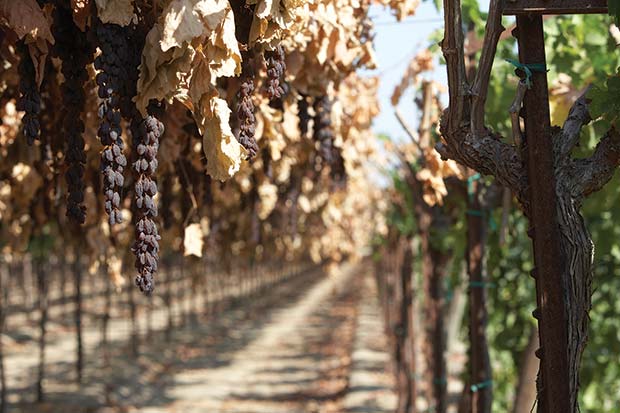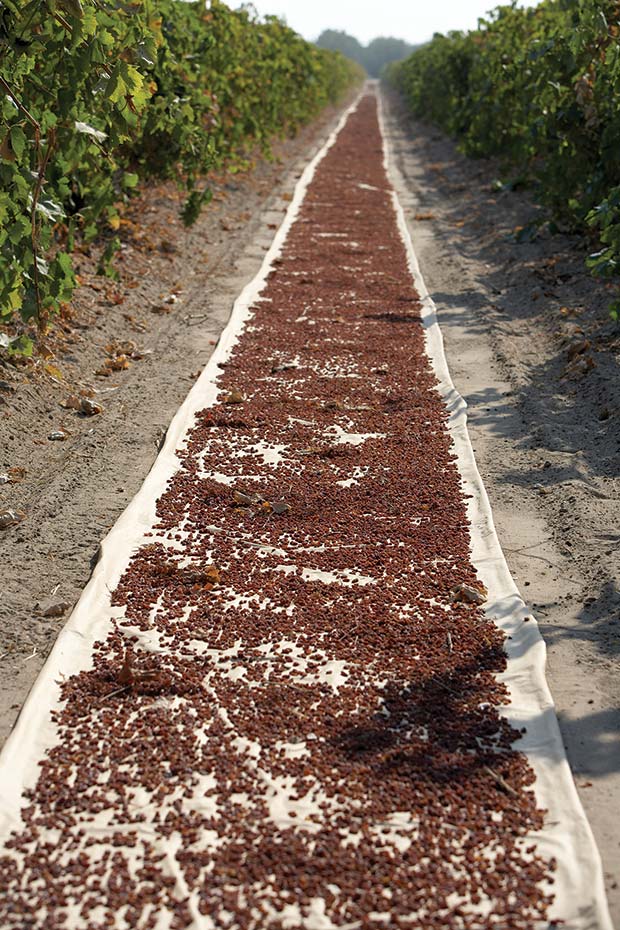California raisins in the UK adopts a positive stance despite a tougher than normal year.

There is no such thing as a ‘normal’ year in dried vine fruits and this year has been no exception. California Raisins sales overall have slightly decreased by 11% from 110,304 to 96,386 short tons.
Europe experienced the biggest shortfall of imports at 20% less than the previous year. Turkey and South Africa both flooded the EU with fruit which suppressed demand generally across the region. The 2015 South African crop proved to be the 2nd largest for some time of 55,000MT following the record year in 2014 of 63,000MT and so the EU is the first destination for the excess fruit from South Africa. Domestic consumption of South African fruit is around 35,000MT.
Despite California Raisin exports to the UK showing a slight decrease, the UK remains the second largest export market for California raisins. Despite being down by 30% the UK totalled 8,290 tons to June 30th 2015. With exports to Ireland included at 1,055 tons this total increases to 9,345 tons. Ireland has proven to be a an increasingly important destination for California raisins, this year exports to Ireland increased 97% from 620 to 1,222 short tons. Although the overall UK tonnage represents the lowest total for some years, it is nevertheless a reasonable performance when we take into account the difference in price between California Raisins and South Africa, and in particular Turkey which was as much as $550 per ton during January and February 2016.

The chlorpyrifos MRL pesticide issue caused much confusion in the dried fruit industry. The EU Commission set a new level of 0.01mg/kg from 0.5mg/kg, which is as close to a total ban as possible. However, lobbying of the Commisson via EU dried fruit importers and a delegation from Turkey resulted in a new level being set for a further year of 0.2mg/kg.
The California Raisin industry have for some years already been working to 0.01mg/kg after chlorpyrifos was effectively banned from rural use in the US during the 1980’s. The reduction of the MRL initially caused Turkey many issues since chlorpyrifos was in wide-spread use there however lobbying by the UK industry which relies on Turkish sultanas helped secure a reduction reprieve to 0.2mg/kg.
I am pleased to say that the sophisticated testing programmes of the California Raisin industry in partnership with the USDA have set safety standards across the globe for raisins. The use of chlorpyrifos is regarded as somewhat old fashioned in California being a ‘wide spectrum’ pesticide. This means that chlorpyrifos will remove even the ‘good bugs’ required for pollination and pest control in themselves. Far more targeted, less invasive pesticides are used by the California Raisin industry which eliminates the need to destroy those insects which are useful for the production of quality raisins, particularly during Spring when pollination takes place. In this way the California Raisin industry has adopted a much more sustainable, Ecofriendly approach to growing raisins, which is of increasing interest to major customers of California raisins worldwide.
At the time of writing, reports suggest that the California Raisin crop is looking healthy for the year ahead, with post 300,000 tons expected once again.
Many people are confused about the difference between sultanas and raisins. The differences are marked, in the same way that Granny Smiths and Pink Ladies are different varietals, theya re still considered apples. Sultanas differ from raisins in one important aspect, the drying. Typically in Turkey the picked raisin grapes remain in the sun for around 10 days or so, often in temperatures of 40 degrees Celsius. They are then dried in a drying agent, typically potash based, which helps fix both the lighter colour and to some extent, the flavour. In California the grapes are left on the ground or dried on the vines until they are completely dried, typically 3-4 weeks. They are completely sundried. This results in the raisins appearing darker in colour and perhaps more importantly inside the raisin many of the sugars caramellise producing a richer, more fruity flavour.
The grape varieties are similar, and although California does produce and export range of other varieties, the majority of raisins come from the Thompson seedless varietals. European manufacturers have used California raisins for over 80 years in a variety of products from cereals, bakery, confectionery, dairy and even in beer production. Snacking across Europe represents an important market for California raisins and is on the increase as the EU consumer becomes more focused generally on eating more healthily. Natural, sun-dried, safe, California raisins fit that requirement perfectly. The future looks naturally sweet for California raisins.
CALIFORNIA RAISINS
Email: info@ukraisins.com




Comments are closed.